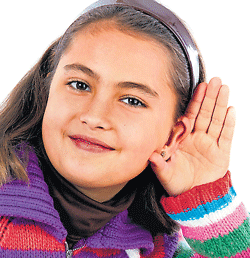Look out for signs of delayed hearing and speech to avoid a lifelong handicap, advises Dr Shrikant Ghargi

A few days ago, a two-half-year old girl walked into my clinic with her parents. She was smiling and playful. Her parents were worried after she displayed signs of delayed hearing.
An oral examination revealed that she had congenital bilateral deafness. This invisible condition was the cause of her delayed speech. Thirty out of every 1000 children have mild to severe hearing impairment (30-70 dB loss) that affects growth and progress of life in infants. One child out of every 1000 suffers from profound deafness (>70 dB loss).
Causes
Hearing loss can be congenital or acquired. Congenital causes can be hereditary or as a result of infections acquired in the womb during pregnancy.
Delayed crying at delivery, birth asphyxia, severe jaundice in the early weeks of life, meningitis-infection of the brain and surrounding membranes and toxic effect of certain drugs such as Amikacin, Gentamycin are some of the causes of acquired deafness.
In some cases, mental retardation can be the cause of delayed speech. But being tongue tied and suffering from frequent ear infections in early childhood do not cause delayed speech or language disorder. If parents carefully observe the development of speech in a child, then detecting a handicap becomes much easier. The milestones in the development of speech are:
- The first three months — the child will begin to respond to loud sounds, will be startled by the sound initially and slowly becomes familiar with it.
- Four to six months — moves eyes in the direction of sound and babbles in monosyllables.
- Seven to 11 months — turns to sound and can babble in bisyllables.
- One to two years — can point to body parts and pictures when asked. Pays attention to music, rhymes. Speaks two-word sentences.
- Two-three years — understands the difference between in and out, big and small, start and stop. Uses two-three-word sentences.
- Three-four years — will respond to being called out from another room. Will animatedly watch TV, taking in the different colours, shapes and sizes. Uses four-word sentences.
- Four-five years — pays attention to short stories and can answer questions about it. This is the age they begin to enjoy being read to and telling stories.
Within the first three years of life, variations in development are commonly seen. But one should look for the causes before declaring the delay as a variation from the normal. In a nutshell, if a child is not babbling after a year, does not speak a word at one-and-half years, knows less than 10 words at two, and cannot speak two-word sentences at three, then medical advice is a must. Don’t wait it out beyond this point to get medical help.
Effects of hearing impairment
Hearing loss in early life affects development of speech and language. As a consequence, behavioural, emotional and social developments too are affected. In a suspected case of deafness or in a child at risk, the following tests can be done to ascertain the diagnosis.
- Acoustic Emission test will be performed on children below the age of five
- Auditary Brainstem Response (ABR) is also performed to find the defect in children below the age of five
- Audiometry is another option
The first two can be used as new-born screening tests. Early detection of cases of hearing loss — preferably below six months of age, and early intervention will not only help in acquiring better speech but also in behavioural and emotional developments. A little care on the part of parents and medical personnel can help in transforming the life of these kids. A life long misery can be averted if this invisible condition is picked up early.
(The author is a child specialist, Apollo Clinic, Bangalore.)